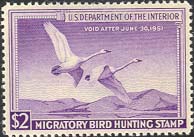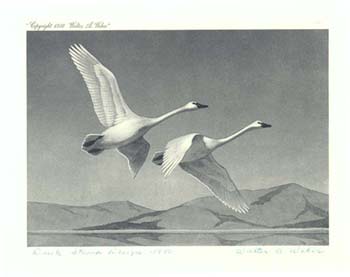

Back to RW17 Back to the Federal Index Home
A LITTLE HISTORY ON THE 17TH (1950-51) DUCK STAMP ARTIST


For Walter A. Weber, the average length of time that it took to do a painting from start to finish was about a month, including the time that he spent researching his subject. Of course this could vary to a great degree depending upon the complexity of the subject. Monkeys simply didn't pose as patiently as mango trees did.
Mr. Weber continued to free-lance from 1943 to 1949 designing, in this period, his first Duck Stamp. by this time, he was drawing in a style quite different from that of his youth. He was no longer the boy in Chicago who sold ten cent drawings for a bottle of soda pop and a few art supplies. In 1949, he stopped free-lancing to accept a position as staff artist and naturalist for the National Geographic Society.
In this position both his art and zoology training served him well. While working for the national Geographic Society, he spent many months each year in the field. There with a wealth of material to work from, he researched, painted, and undoubtedly added to the collection of bird specimens that he had started years before. It is estimated that there were about 2,000 painting in that priceless collection.
Mr. Weber was the recipient of the Conservation Service Award. This award was presented to him by the U.S. Department of the Interior on April 18, 1967. It represents the highest civilian honor the Department can bestow. The Interior Department's assistant at the time was Stanley A. Cain, who had been a good friend of Mr. Weber for many years.
Secretary Cain made the presentation to Mr. Weber, saying, "As staff artist for the National Geographic Society you are truly one of the outstanding wildlife and nature artists in the nation today. You acquaint persons in all walks of life with the conservation goals of the Department and inspire them to a wider interest in our native wildlife."
The National Geographic magazine is a publication noted for its photographic excellence and the quality of color photography is increasing all the time. This does not, however, relieve the scientific illustrator at all. Mr. Weber always said that a color photograph, no matter how beautiful it may be, could not show every intimate characteristic of a subject that might be desired. It takes the artist's eye to capture the quality of an animal that makes it more real than the most realistic photograph.
-------------------------THE ART-------------------------
Trumpeter Swans was painted in watercolor wash and gouache. The print was a
fine-grained gravure, hand pulled on white paper using blue-gray ink. The prints
were hand signed in both pencil and ink but not numbered. This was Walt Weber's
second print in the Duck Stamp design. This was the first national open competition.
The image size of the print is 5" x 7".
-------------------------THE STAMP-------------------------
Trumpeter Swans...Engraved by the Federal Bureau of Engraving from the original artwork.
Printed in brilliant bluish purple ink. The stamp sold for two dollars.
Postal records show 1,903,644 stamps sold. First day of sale was July 1, 1950.
Most of the information contained above is from the book Federal Duck Stamp Story, Fifty Years of Excellence, by Laurence F. Jonson; Alexander & Co. It is used here with permission from the author. For more information on this book, please click here.